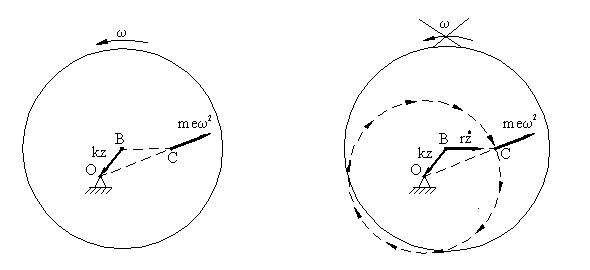|
THEORIES ON ROTOR DYNAMICS Vibration Theory of Rotor Dynamics 1. Basic initial equation of the rotor dynamics under "vibration" theory is: Mr. Y. Kozheshnik believes it fail. He think two forces taken into account by the equation (1) form no closed triangle of forces (see Figure 1).  It is clear that other scientists agree with falsity of the equation (1). These scientists now apply the following equation in their studies:  Left part of the equation (2) is a part of free vibration equation of a system with one degree of freedom. Right part of the equation is a force cycling on the plane perpendicular to the system vibration axis. But equation (2) like equation (1) consists of two forces that form no closed triangle also. Meaning of force cycling is not clear, if other force does not cycle because the system has only one degree of freedom. Additionally, note that any theory omits description of the same process by two different equations ((1) and (2)). 2. To correct the equation (1), it was made an attempt to insert the aerodynamic drag forces. The third force allowed closing the triangle of forces.  Consequently, the equation (4) appeared.  It is clear that new equations (3) and (4) are fallacious, if we take into account that the triangle of forces are "coupled" with a fixed point. Due to this the triangle of forces and, therefore, rotor should rotate about this point with a constant acceleration for unlimited time (see fig. 2). 3. Note also, that equation (3) only enabled getting dependence to determine an angle of the rotor turn about geometrical axis.  However, assume that the rotor rotates under vacuum conditions (r = 0), so the dependence (5) "self-destructs". At the same time, the rotor rotation process under vacuum conditions is analogous to the rotor rotation subjected to the aerodynamic drag forces. 4. Existing "vibration" theory is low-informative. So equation (3) provides availability of a critical speed, allows getting dependence to evaluate this speed, determining a distance between rotation axis and center of mass and the rotor turn angle. In addition, it denotes a possibility of the rotor self-alignment. This is a limit of the "vibration" theory comprehension. (Accuracy of this information has not been considered in this case.) 5. Existing "vibration" theory collected data on the rotor dynamics features, but is unable to explain these effects and indicate ranges of effects. These effects include resonance effect; Sommerfeld effect; self-vibration effect; effect of direct precession about shaft. Therefore, based on equation (1), we can deduce that the rotor at unlimited acceleration self-aligns. However, it is impossible to explain why it occurs. Accumulated data on the rotor rotation features is insufficient. So, It does not reflect the rotor retrograde precession at changing of the turn angle from 90 to 180 . A fact that there is no a way to stabilize the rotor position within angle range of 90 to 180 had not been founded. 6. The solutions of equations of "vibration" theory could not be applied to identify an unbalances, although the rotor unbalance identification is an inverse problem of dynamics. Due to this, the "vibration" theory is actually unusable in the theory of rotor balancing. The theory of rotor balancing emphasizes comparative analysis of the tests rotor launches with test loads. 7. General issue of the "vibration" theory is a statement that the rotor shaft performs bending vibrations (like planes of turning folk and spring beam). Actually, the shaft bends and rotates about the rotation axis in deflected position. 8. Another important issue of the "vibration" theory is assumption that the rotor on the flexible shaft has one degree of freedom. In real environment, the rotor not only deflects from the rotation axis, but also has a possibility to rotate about geometrical axis. Evidently, that the rotor on shaft has two degrees of freedom. 9. According to the "vibration" theory, the torque is consumed to overcome the aerodynamic drag only. It is assumed that under vacuum conditions the torque equals zero if the rotor rotates with a constant speed. Nevertheless, it contradicts well-known Sommerfeld effect. We can adduce other evidence of equations (1-5) falsity, but provided proofs are sufficient. |